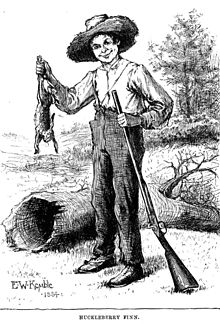Recently, author Lee Nelson completed the novel based on his knowledge of the American West. Not surprisingly, he gave the Indians more depth than Twain's one-dimensional portrayal. Let's take a look.
[**spoiler alert**]
Nelson begins where Twain left off: with the heroic Brace Johnson surveying the Sioux camp where the Indians hold his sweetheart Peggy Mills, her sister Flaxy, and ex-slave Jim. Enraged by Peggy's defilement, Johnson launches a suicidal one-man attack on the Indians. He kills one or two but they quickly overpower and cripple him, then kill and mutilate him.
Johnson's fate seems horrific, but mutilating him after he's dead obviously doesn't hurt him. More to the point, the Indians didn't necessarily know who was attacking them. If they knew Johnson, they didn't necessarily know why he was attacking them. When a crazed enemy launches an unprovoked attack, you can be forgiven for reacting in kind.
Huck to the rescue
With Brace dead and Tom gone to fetch help, it's up to Huck to save Peggy, Flaxy, and Jim. He observes the camp at length. Here's where Nelson starts drawing a clear distinction.
For starters, the Anglo girls fall into the rhythm of camp life> They perform chores just like Indian girls. Other than the initial "defilement," which is only alluded to, the Sioux treat the girls like members of the tribe.
Also, Huck is careful to blame the Mills family massacre and Peggy's defilement on Blue Fox and his men. You know, the actual Indians who committed the crimes, not the whole tribe or all Indians. This is a testament to Huck's essential fairness--the same quality that led him to help Jim flee slavery. And to author Nelson's essential fairness in making Huck's choice for him. Unlike Twain, Nelson doesn't seem prejudiced against the entire race of Indians.
As for Jim, the Sioux initially leash him to a pole and assign him to scrape hides. But soon an Indian brings him a drink and unties him. Jim continues his scraping voluntarily. He's eventually joined by an Indian woman ("squaw") who seems to like him.
When Huck finally reaches Jim, Jim says he doesn't want to leave. The Indians have treated him like an equal, and the woman obviously thinks he's a full-fledged man. Unlike white men, the Indians don't consider him inferior because of his skin color.
Nelson is showing us the propensity of Indian tribes to convert runaways and captives into members without prejudice. Tribes made political and cultural distinctions, of course, but they didn't make racial ones. In general, they weren't prejudiced the way Europeans were.
The rest of the book
Before Huck can do anything, the Sioux sell the girls to two unsavory trappers. Nelson doesn't shy away from noting that some tribes sold women and children to other tribes, Mexicans, or the occasional white man. But they're relatively kind as slave masters go. They don't strip Peggy, whip her, or chain her. When she insists that Flaxy must go with her, they agree.
Huck spends the rest of the novel pursuing Peggy, rescuing her from the trappers, and getting her to safety. Along the way he meets an Indian with amputated legs who hobbles around on the stumps and depends on charity to survive. He encounters a tribe where a runaway slave has become chief--again showing the Indian willingness to treat all races as equals. Jim eventually returns to this tribe and becomes its co-chief. And a tribe of peaceful Indians (Goshutes?) who farm and dress in Western clothes. When Huck gives them some of his food, he and Peggy become their honored guests.
There are no more depredations by "evil" Indians. Huck worries that he or his friends may run into dangerous Indians, but it never happens. Basically, all the savagery happens in Twain's part of the book and none in Nelson's.
Nelson's portrait of Indians is balanced. Like anyone else, Indians are capable of killing or enslaving people, but also of helping and honoring them. In contrast, Twain's portrait is pure racism. To him, Indians are treacherous, murdering scum with no redeeming qualities.
Rob's review
Some critics didn't like the Twain/Nelson collaboration, saying Nelson failed to match Twain's high standards. I think Nelson made Huck's travels more varied and interesting than Twain would've done. The ending is especially fitting, as Huck--the boy without prejudice against blacks, Indians, or "defiled" women--gets a well-deserved reward.
Huck and Tom is a cross between a rollicking boys' adventure and an Old West travelogue. Sure, it has flaws, but it's worth reading. Rob's rating: 8.0 of 10.
For more on the subject, see Why Not Rewrite Twain's Books? and New Huck Finn Eliminates "Injun."


1 comment:
This is the advantage of the expanded universe concept, really. It leaves itself open for alternate character interpretation.
Post a Comment